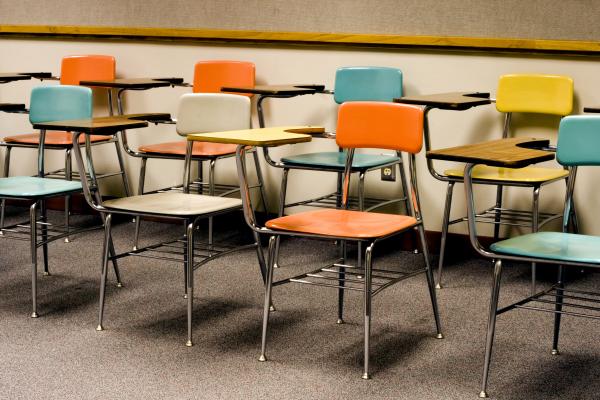Things were going well with Amelia Jenkins’ teen book club. Conversations were flowing, and the kids were getting more comfortable with each meeting. Jenkins found a short story perfect for group discussion, so she printed out copies. When she arrived at the book club, story printouts in hand and ready to get started, the packets were confiscated – the story would not be read that day. Why? Staples. Jenkins had stapled the packets together.

Jenkins, the youth services librarian at Juneau Public Library in Alaska, was not at her library. She was at the Johnson Youth Center, a juvenile detention facility and the location of the teen book club.
Within the confines of a detention facility, there are, of course, challenges to navigate. Especially if you are coming in with little or no prior experience. Michelle Ogawa is the teacher librarian at the Alice M. Worsley School, located at California’s Fresno County Juvenile Justice Campus. Ogawa has a unique perspective as a librarian “on the inside.” She knows about the no-staple rule, for instance, but more so, she knows that working in a detention facility means riding a wave of changing logistics and rules.
No staples allowed inside, no hardcover books, no handshakes, the list goes on and varies by facility. But librarians, like Jenkins, who collaborate with these facilities, or like Ogawa, who work within them, will tell you that’s it all worth it. And they have some tips that librarians should know before working with juvenile detention facilities.
1. Flexibility is everything
Ogawa and Jenkins place this tip at the top for a reason. Flexibility will have the utmost importance in almost everything you do in a juvenile detention facility.
“Flexibility while working in a structured institution is very important,” Ogawa says. “The kids here are kept busy from the minute they wake up until the minute they go to bed, so we need to find a time that works. Right now, our book club meets at 7:30 a.m. twice a week. Ideally, we’d prefer for this to be in the afternoon or at the weekend, but there are limits to what we can do.”
If you’re a librarian coming from outside of the facility, keep in mind that schedules won’t be set in stone. Things can change quickly, and book clubs can be canceled on the day with no explanation. “I don’t know what’s going on inside every day, nor do I need to know,” Jenkins says. “Be open and accepting to new situations, even if it throws you off a plan.”
Even if you end up with an early morning slot or if something happens that cuts your discussion time in half, flexibility will keep you going. Ogawa says kids are voluntarily lining up to attend her book club, even early in the morning. “Kids of all reading levels, from proficient readers to non-readers are on the waitlist to join,” she says. “Once you are willing to work around logistical or scheduling challenges, you find the time and make it successful.”
2. Get ready for a lengthy process
Even before you make your first introduction to a juvenile detention facility, know that it can take a while to get started. If you want to begin a book club and get started right away, know that that’s probably not realistic. Remember that you are not volunteering at a typical youth-serving organization – there will be a lengthy vetting process beforehand.
“There are background checks and other applications to complete,” Jenkins says. “It’s an intense process, and you might end up waiting a long time before you hear back on anything.”
Processing times will differ depending on the facility but be prepared for paperwork no matter the location. Be persistent and don’t abandon the project just because there is a long waiting period.
3. Introduce yourself to a teacher or librarian inside the facility
If you think you’re ready to get started on this work, start by introducing yourself to someone who works there.
“It’s a great starting point,” says Jenkins. “Once you are connected to someone, let that person guide you through the process of how things work.” Facility staff are more likely to be receptive to introducing a supplemental program, like a book club, if a fellow staff member advocates for it.
“The best advocacy comes when you cross that hump of getting it started,” Ogawa says. “Once you get that momentum and introduction built, then you find the challenges become less and less. All of us who do this type of work do it because we want to serve kids no matter what part we play. Sometimes it’s about getting through those logistical hurdles to get others on board.”
4. Relationships are key
Once you form a relationship with a staff member, keep them as your primary contact. “Be comfortable enough to ask your contact as many questions as possible,” Jenkins says, “especially about specific rules.” Jenkins recalls an early experience at the facility when she went in for handshakes not realizing that it’s against the rules for students to touch. Mistakes like this can be avoided if questions are asked ahead of time, but also know that fumbles will happen and don’t take it personally.
It’s also important to know that every facility has its own unique culture, and this can be seen through the relationships between probation staff and school staff. Joe Hammond, principal of the Alice M. Worsley School, says that crafting relationships with staff is important.
At the Worsley School, there is already a strong culture of reading, but if you want to enter a facility that might not have that foundation built, be ready to do more advocating. Hammond says, “When a facility might not have a good relationship between its school and probation staff, getting an outside ask approved, like a book club or another supplemental program, might be tough.”
If you can successfully start a program, work on building relationships with probation staff to ensure collaboration is always there.

5. Plan your content before
We are living in a time of book bans and book challenges – including many banned titles for young readers. Depending on your state, you might have trouble bringing certain books into juvenile detention facilities, or you might not be allowed to bring in outside books at all.
“Pre-read books for content,” Ogawa advises, not just because it might be a banned title, but because it might contain sensitive themes. “We are fortunate that book censorship has not become an issue, but I would still advise to be careful when choosing books – not just from a censorship perspective but from the teen perspective as well. Students in these facilities will have themes and content that might be too sensitive for them.”
If you still want to use a title with a sensitive scene or theme, Ogawa suggests preparing the readers beforehand. “Make it part of the book discussion,” she says. “Have them discuss why the author felt it was important to add this scene or use that type of language.”
“Be prepared for what is controversial or sensitive to change,” Jenkins says. Along with the importance of being flexible, “certain things might come up in a student’s life that make it hard to continue to work on a specific book. Life happens.” If you need to abandon a title for any reason, be OK with that.
Something else to be mindful of when planning a book club is to consider facility rules regarding hardcover books. For Ogawa’s facility, hardcover books can only be used within the classroom and can’t be taken outside of class for students to read during free time. This made it a challenge when her short time slot also had to accommodate reading. While reading as a group had its benefits, Ogawa says, providing paperback books would have circumvented the situation.
6. Remember that you are a guest
If you are an outside librarian working inside a juvenile detention facility, remember that you are a guest within that building. Along with being a guest come rules and a culture that you might not be used to.
“We had a beautiful poetry workshop at the facility,” Jenkins says. “The students were so deep in the moment, but we were abruptly stopped in order for the kids to move on to the next portion of the day.” In your own library, you might let this program run over time to wrap up and let participants reflect on a powerful workshop. At the facility, however, that isn’t an option.
“Staff inside the facilities are coming from very different backgrounds from my public library world,” Jenkins says. “Some of them can feel strict and very structured, but this is just their own way of doing right by the kids.” It’s important to encourage yourself to take on a new perspective and be open to running programs differently than you do at your library. Building those relationships with probation staff also plays a key role here.
7. Have fun
You can have fun and build community even if you only meet once or twice a week. Ogawa creates small celebrations and incentives for her students like bookmarks, stickers, virtual author visits and, of course, food. Bringing food from the outside (breakfast burritos are a huge hit with Ogawa’s students), is a big deal when compared to the day-to-day institutional food.
Jenkins advises asking your staff contact about incentives beforehand. Things like Sharpies, for example, are sometimes not allowed inside. The rules can change every day, so don’t show up to your program with a pizza or other outside materials without checking in first. Permission is needed, but fun is still possible.
“Our kids are excited about reading because the adults who work with them are,” Hammond says. “It has everything to do with how the classroom looks and feels, but it’s also about how the time is structured and, most importantly, how the kids feel about the adult in the classroom with them.”
Little things go a long way, and adding bits of joy into a book club will make it stand out from the everyday routine. Why else are kids lining up for book club at 7:30 a.m.?

8. Utilize free resources
Ogawa and Jenkins are both veteran participants of ALA’s Great Stories Club (GSC) and are currently using books from the program’s themes in their respective book clubs. The books were chosen because teen readers can relate and see themselves or parts of their own story within the text. Great Stories Club resources, including a program guide and discussion questions for each theme, are a great way to get teens interested in reading, both inside and outside of juvenile detention facilities. While ALA occasionally offers GSC grants to help libraries purchase books and fund supplemental programs, the resources are free and available to all.
“The well-vetted discussion guides and program guide are essential to my work,” Ogawa says. “I would recommend anyone working with teens to read them to inform planning for book club meetings.”
Great Stories Club resources can be utilized for any book discussion, not just for titles in a theme. Read more about how to use the Great Stories Club to reach teen readers and build a successful book club.
Other recommended resources include ALA’s Library Services to the Justice Involved member interest group and The Journal of Research on Libraries and Young Adults’ essay on critical issues in juvenile detention center libraries.
“Ta-Nehisi Coates is from a different generation or culture from my students, but they relate to his experience of being disenfranchised,” Ogawa says about Between the World and Me, a title part of the Deeper Than Our Skins Great Stories Club theme. “We have kids who have never read a book cover-to-cover, and they are doing that for the very first time with these books.”
Like many teens, the students you’ll work with inside a juvenile detention facility often feel as if they have no voice. “Every book club, I learn something from the students that blows my mind,” Jenkins says. “Without having any context on their lives, I know that they are insightful and interesting, and they are not often asked their opinions on things. This gives them that chance to speak and we want to reward them for participating so thoughtfully.”



